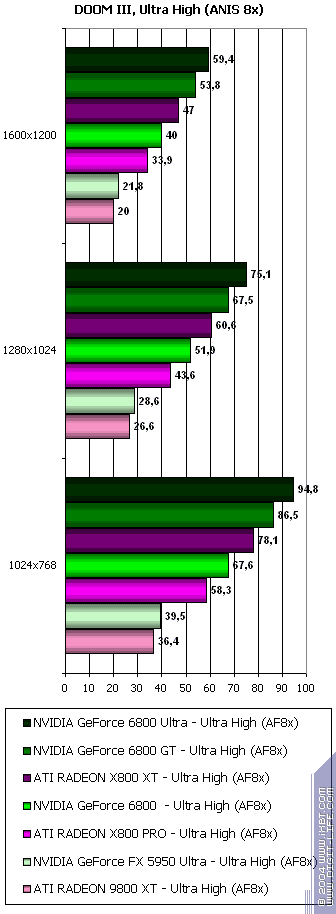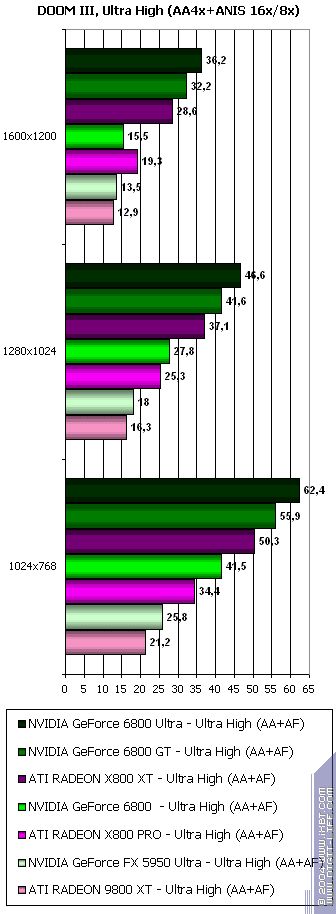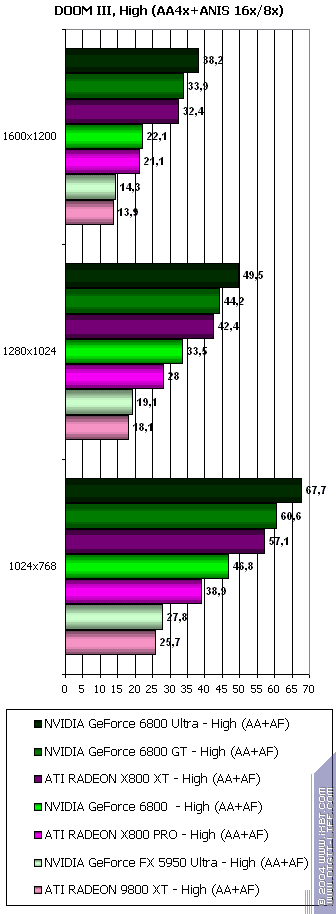 |
||
|
||
| ||
Contents
I will not blow the trumpet and shout that the long-expected event has come true. We shall publish a separate article about DOOM III later, where the game and its features will be reviewed and analyzed. So those of you who have opened this article to learn something about the game may relax and have some coffee before plunging into the Martian battle or before uninstalling the game and complaining in forums that the game did not come up to your expectations of a miracle... I'm a tester above all, and for me this game is a new benchmark to analyze the performance of video cards. Even if in the long run the majority of gamers declare it the worst sequel from id Software, the performance of video cards in this game will still remain very important because the DOOM III engine will be used in other games to be released in future. It goes without saying that first of all I tested the latest generation accelerators, many people want to know their disposition in this game. These are ATI RADEON X800 Series and NVIDIA GeForce 6800 Series. We have published a lot of articles about these cards, so I will not dwell on the features of these GPU. If you wish, you can look through the list of the past articles on the subject.
Theoretical materials and reviews of video cards, which concern functional properties of the GPU
I have added two more video cards to the existing five video cards of the latest generation: to estimate the advantage over the past colossi from the previous generation. And as GeForce 6800 still has no match in the ATI camp, it will be interesting to compare this low-end product from the new series with the past idols of hardcore gamers. By the way, I want to note the buzz circulating in Internet about the forthcoming release of ATI RADEON X800 XT (not PE), which will become the competitor for GeForce 6800 GT, and X800 PRO will take one step down and will compete with GeForce 6800. That's why I compared 6800 not only with the past kings of 3D graphics but with X800 PRO as well. So, it's high time to introduce our contenders. Video Cards
I suppose there is no point in commenting on these cards, all of them were tested in our lab.
Installation and DriversTestbed configurations:
VSync is disabled. Note that we used a beta version of CATALYST 4.9, which contains ICD OpenGL (alpha version) rewritten from scratch. The driver is still in the development stage, so the current ATI test results can be considered preliminary. Without this driver the ATI test results would have been worse by 20-40%, but let's not put the cart before the horse and see the performance. Test results: performance comparisonWe used the following test applications:
If you want to get the demo-benchmarks, which we use, contact me at my e-mail. Concerning the benchmark, we did not use Demo1 installed with the game but recorded our own demo instead - SAM3 (timedemo sam3 console command is used for the test) This is done to avoid possible optimizations for the existing game benchmark. Important information: The maximum FPS in the game is limited to 60 frames per second, but when we run timedemo this limitation is lifted. There is no point in measuring the minimum FPS, because even the most powerful 3D accelerators may often slump to 15-20 FPS, so it's not the issue. AF8x modes on the diagrams mean Anisotropic 8x Quality; AA+AF - Anisotropic 16x Quality (FX5950 - 8x Quality) + Anti-Aliasing 4x Quality
Ultra High Quality Mode
In this mode texture precompression is disabled and anisotropy 8x is activated by default. 

High Quality Mode
In this mode texture precompression is enabled and anisotropy 8x is activated by default. 

Summary table of performance differences

Test results: quality comparisonOne could say right away, that in 90% cases you will not see any difference at all, because DOOM III is mostly roaming in dark scary nooks, which are sometimes lighted by lamps and hell fire, which is quite enough to get a complete idea of the devil's lair in our understanding. That's why I will provide examples, where you can at least make out some details.
Note the lack of obvious glitches to be seen, there are just some
rendering differences between ATI and NVIDIA. As we can see, there is almost no difference, except for the grating in the first example. This is probably due to different implementations of filtering (optimization), or for some other reason. ConclusionsThus, about the speed on the whole:
We have already mentioned the quality, on the whole there is no difference. So we can certify that at this stage NVIDIA GeForce 6800 (the entire series!) is much more attractive for DOOM III than the ATI X800 series. Of course, the driver will improve, but even if we assume that ATI would manage to level the performance of its top X800 XT with the rival 6800 Ultra, in all other cases it's difficult even to count on that, the advantage of NVIDIA is too great. Such poor results of ATI and brilliant ones of NVIDIA are easy to explain. We all remember from the release of DOOM III Alpha (its leakage, actually) that the salt of the game is in active shadow usage implemented via the stencil buffer. NVIDIA has been assuring us since the times of GeForce FX that Z operations and stencil operations are accelerated twofold in comparison to pixel operations. So with its 16 pipelines 6800 Ultra processes 32 Z and stencil results at a cycle. This is not the case in ATI cards. Then, you should not forget about UltraShadow, which optimizes the shadow processing operations of video cards based on NVIDIA chips (truncating unnecessary work in scene parts). Though it's difficult to say how effectively it all works in this game. And the last stronghold of NVIDIA success (but not the least) is shader optimization (right up to replacing them with more effective and faster ones). Of course we mean the useful optimization without the quality loss. What concerns weaker video cards, we shall test their performance in different modes later. It goes without saying that the High Quality and Ultra High modes are out of the question. So you know, you cannot expect the high quality graphics here. DOOM III in all its glory is still for the most powerful and expensive accelerators. And don't forget about the demands to the CPU, system bus, and memory. Yes, DOOM III can almost completely drain the upgrade purse of a devoted gamer.
More games based on the DOOM III engine are coming, but the nearest release is of the long-awaited Half-Life2, so we are looking forward to new discoveries.
Write a comment below. No registration needed!
|
Platform · Video · Multimedia · Mobile · Other || About us & Privacy policy · Twitter · Facebook Copyright © Byrds Research & Publishing, Ltd., 1997–2011. All rights reserved. |